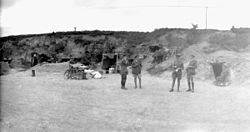Canadian Corps
| Canadian Corps | |
|---|---|
|
Canadian Corps Headquarters, Neuville-Vitasse, France, 1918
|
|
| Active | 1915–18 |
| Country |
|
| Branch | Assigned under the Canadian Expeditionary Force |
| Size | 4 divisions |
| Part of | British Army |
| Commanders | |
| 1915–1916 | General Sir Edwin Alderson |
| 1916–1917 | General Sir Julian Byng |
| 1917–1919 | General Sir Arthur Currie |
The Canadian Corps was a World War I corps formed from the Canadian Expeditionary Force in September 1915 after the arrival of the 2nd Canadian Division in France. The corps was expanded by the addition of the 3rd Canadian Division in December 1915 and the 4th Canadian Division in August 1916. The organization of a 5th Canadian Division began in February 1917 but it was still not fully formed when it was broken up in February 1918 and its men used to reinforce the other four divisions.
The majority of soldiers of the Canadian Corps were British-born until near the end of the war, when the number of those of Canadian birth who had enlisted rose to 51 percent. They were mostly volunteers, as conscription was not implemented until the end of the war (see Conscription Crisis of 1917). Ultimately, only 24,132 conscripts made it to France before 11 November 1918. In the later stages of the war the Canadian Corps was regarded by friend and foe alike as one of the most effective Allied military formations on the Western Front along with the First Australian Imperial Force and New Zealand Expeditionary Force.
Although the corps was within and under the command of the British Expeditionary Force, there was considerable political pressure in Canada, especially following the Battle of the Somme, in 1916, to have the corps fight as a single unit rather than have the divisions spread out through the whole army. The corps was commanded by Lieutenant General Sir E.A.H. Alderson, until 1916. Political considerations caused command to be passed to Lieutenant-General Sir Julian Byng. When Byng was promoted to a higher command during the summer of 1917, he was succeeded by General Sir Arthur Currie, the commander of the 1st Division, giving the corps its first Canadian commander. Currie was able to reconcile the desire for national independence with the need for Allied integration. He resisted pressure to replace all British officers in high-ranking positions, retaining those who were successful until they could be replaced by trained and experienced Canadians. British staff officers made up a considerable part of the Corps – although by 1917, 7 of 12 infantry brigades were commanded by Canadians trained during the war, British regulars were the staff officers of the divisions and British officers held two-thirds of senior appointments across the infantry, artillery and Corps headquarters with only four of the most senior appointments being Canadian. Among the British officers were Alan Brooke (at the time a major of the Royal Artillery who planned the artillery barrages for Vimy Ridge and later) and William Ironside. Both became Field Marshals and held the position of Chief of the Imperial General Staff.
...
Wikipedia

